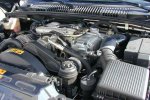More info on Why not to Supercharge from a good and trusted friend of mine.
Why (We) wont touch anything with a ( certain type of )supercharger. We could easily do a chip for the ( certain type of )supercharger, but there are a lot of good reasons for us not to & not to sell you one! This is just another good reason why,, I had a 4.6HSE (GEMS) melt a piston on the Dyno. This cost me a lot to sort out, but I learned a lot from it and hopefully I can prevent my friends from making the same mistakes.
The wreckage of the engine was analyzed by (A certain Company), Europe's leading supercharger specialist. His summary was that the system "could never be set up properly in its present form" and is "unsuitable for the purpose for which it is sold".
Perhaps now is a good time to look here!! (you will find Pics and info here)
All of these seven major failure modes were exhibited in the engine, which had the system fitted for 9000 Miles:
1. Extremely poor air distribution within the inlet manifold, leading to major mixture errors between cylinders. (This also confuses the GEMS adaptive engine management system).
2. Cylinder bore washing on rich cylinders.
3. Trappingof piston rings and gudgeon pins in some cylinders caused by piston collapse under chronic long-term detonation.
This would have led to a small end seizure and a rod through the block within another 2000 Miles.
4. Early stages of head gasket failure on most cylinders, possibly influenced by item 3 above.
5. Severe camshaft wear, which is probably largely responsible for oil loss by crankcase pressurization. This has been observed in other supercharged engines, although the connection (if any) is unclear.
6. Insufficient engine breather capacity, leading to oil entering the bores past the piston rings and lowering the Octane rating of the fuel, hence exacerbating the detonation problem.
7. Large quantity of oil leaving the breather system. Because of the breather arrangement this almost exclusively went down the number two cylinder inlet runner, causing detonation problem.
Simply rebuilding the engine could not cure items 1-3. Over seven years working with several hundred Rover V8 engines, I have never seen so many major problems in one instance. It is clear that the ninth injector is required mostly to fuel the front four cylinders, which perform the bulk of the work. Because of this the conversion is also extremely vulnerable to failure of the ninth injector system, which will guarantee the destruction of the engine in seconds.
Bearing in mind that these faults take several thousand miles to develop, you can have no knowledge of what state the engine is in when you apply a chip upgrade. So when it blows up your customer would blame you for it, and I expect you would get a call from his lawyer/attorney/solicitor/leech/other parasite
(Sorry Lawyer's No Insult intended.)
So, "I" had to pick up the tab on my own because I made the change that destroyed the engine (by fuelling it correctly!!!), despite the fact that it would have blown up within 2000 more miles. Ironically I was only working on it because the original supplier could not cure the chronic pinking problems.
You may also be interested to know the power figures. A standard 4.6HSE makes 205 BHP on our Dyno. This one made 225BHP (with over 10% CO) when it came in. When I had set it up it made 255BHP just before it went bang. We can achieve this with cam, heads and chip.
Hope this is some help to you. My advice is don't get involved - Keep Selling your successful 4.6 stage 3 or 4.8, 5.2's instead! After all 334 bhp from your (5.2Efi stage 4) is a real engine so stay with it.> MARK
